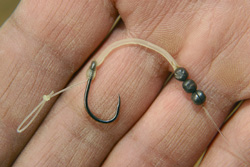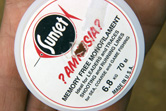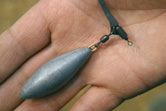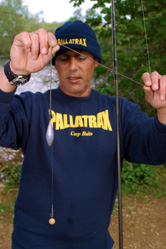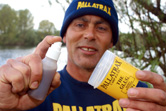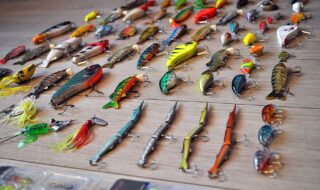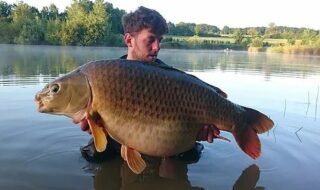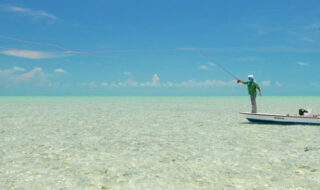Clive Owden looks at the rig he uses when going for an all-out big hit at Horseshoe Lake. He also reveals what hook baits he uses and why…
THE Carp Society’s Horseshoe Lake is one of the country’s carp fishing jewel, writes Jim Foster. Not only does it contain some of the prettiest carp in the country, but it also contains a massive head of fish in the 20 to 30lb bracket – making it the perfect venue if you want to do some ‘big hit’ angling.
What is big hit carping? Basically, it’s when you set out your stall in one swim, spodding loads of bait out over the course of a 24-hour session (preferably longer) in an attempt to get a big shoal of fish feeding hard in front of you. Then, once you have achieved this, the aim is to bank one after the other for the duration of your trip.
One of the UK’s experts at this style of carp fishing is Clive Owden. Clive, who is head bailiff at Horseshoe, has been fishing the lake for many years and has experienced a huge number of big hits, comprising more than 20 fish in just 24 hours of fishing.
“Subtlety isn’t the key to rigs when you want to catch a lot of big fish in one session,” said Clive. “The emphasis of my rigs is placed on strength and reliability.
“I use 15lb clear Amnesia hook links tied to size 6 Raptor T-4 hooks. I tie the hooks on with the knotless knot, using a stiff hair, and also attach a length of clear shrink tubing to the hook – which I bend round to create a spring effect that helps hook the carp once it has taken the hook bait in.
“The Amnesia, I think, makes a superb hook link material,” continued Clive. “It’s fairly stiff, which means it doesn’t tangle very often, and it’s exceptionally strong.
“I reuse my rigs time and again – if the hook point is still sharp and if the hook hasn’t been bent out of shape during a previous capture. Amnesia allows me to do that. A single Amnesia hook link is strong enough to cope with banking one 20-pound carp after another.
“The last thing you need when the carp are going mad for your bait is to have to keep on retying rigs after each capture. Amnesia means that, most of the time, you don’t have to; and Raptor hooks are also usually strong enough to deal with repeat captures.
“However,” warned Clive, “that’s not to say you shouldn’t be careful. Keep an eye on your rigs all the time. If the hook looks like it’s going blunt, or has been weakened, change the rig.”
The Shrink Tube
The most interesting part of Clive’s rig, as far as we could see, was the loop of clear shrink tube he attaches to the eye of the Raptor hook. Bent round into a half circle, it’s a rig that’s designed for use with popped-up hook baits – and it’s devastatingly effective.
“It’s a version of the famous Withy Pool rig,” explained Clive. “The tube not only acts as an extension to the shank of the hook, but the curve in it is what is really important.
“When a carp takes a bait attached to this rig into its mouth, the tubing straightens slightly. Because it’s been bent into a semi circle, when it’s straightened the tubing is going to want to close again – and it’s this elasticity, this gripping effect, that helps pull the hook home.
“As hook bait I will either fish with a single 15mm Pallatrax Jungle pop-up – matching the boilies I’ve spodded in – or with two mini pop-ups.
“To be honest, if your spodding achieves the desired effect and you get the carp feeding like crazy, it shouldn’t matter whether you fish with a small hook bait or a big hook bait,” said Clive.
“To weigh the pop-up down, I pinch three No1 or No4 split shot onto the Amnesia just below the tubing. I don’t pinch them on too hard. This ensures I don’t damage the Amnesia, but Amnesia is so tough anyway that split shot like that is unlikely to harm it.”
Length Of Tubing
So, how long should the clear shrink tube on the Withy Pool rig be, we ask Clive? And how does he get that curve in it?
“I vary the length of the tubing according to the swim I’m fishing,” he replied. “The weedier the swim, the more tubing I’ll use, and the straighter the tubing will be. This will ensure the hook bait fishes higher off the bottom, hopefully away from the weed.
“The length of tubing you see in the step by step pictures is about right for swims that aren’t too weedy. You want the finished length to be around one and a half to two inches long, with the end of the tubing bent round so it’s opposite the hook’s point.
“I achieve the necessary bend by heating the tubing over steam to start with. To achieve the perfect curve, it’s best to bend the tubing round something while you’re shrinking it. I use a wine cork.
“The cork I use actually has several grooves cut into it. Each groove gives the finished shrink tube a certain curve, from almost straight right through to the semi circle in the rig pictured.”
The rest of Clive’s rig was simple. He used an uncoated 3oz lead on a Nash lead clip, with a three-foot length of 0.75mm anti-tangle tubing up the line to absolutely make certain that tangles were not going to happen.
Clive’s Top Rig And Hook Bait Tips
|
|
||||
|
|
||||
|
|
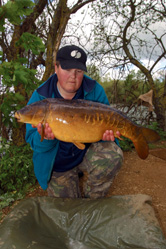 |
| Shimano consultant Ian Poole with one of his fish caught from the baited area |
Mirror For Poole
After we’d finished talking about his rig and photographing it, we were two hours into the session.
Ian Poole, who was sharing the double swim with Clive (the swim was known as the Disabled Point) then got a run and promptly landed a fabulous-looking 22lb mirror.
The two anglers were sharing the same baited patch, with four hook baits between them being cast into an area a few yards wide where the spodloads of bait were being deposited.
“Time for some more bait to go in,” said Clive, once Ian’s mirror had been photographed. “When you catch one, it usually means a few fish have been feeding on the bait – sometimes more. As such, you need to keep the bait going in to keep the fish in the swim and feeding. Otherwise, at Horseshoe, the chances are the carp will simply leave the swim once they’ve eaten all there is to eat.
“You need a lot of bait here because there are many hundreds of carp. They tend to swim round in huge shoals, and when a shoal goes on the feed it can demolish kilos of bait in minutes. If you want a big hit, you need enough bait to keep them occupied while you continue catching – and that can mean almost continuous spodding at times.”
Hook Baits
As he’d already mentioned, Clive’s hook bait was a Pallatrax Jungle pop-up. Depending on how finicky the carp are, he’ll either use a small, double pop-up hook bait or a larger single hook bait pop-up. But why Jungle from Pallatrax?
“Admittedly I am sponsored by Pallatrax,” said Clive. “But I was using their bait before that happened, with Jungle being my choice. It’s a natural looking and smelling bait.
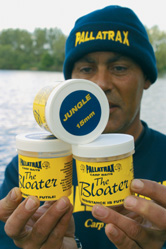 |
| Pallatrax hook baits… Horseshoe carp love ‘em! |
When I saw it and tasted it for the first time, I just knew it would work – and since then I’ve caught loads of fish from Horseshoe and other venues on it.
“I like to dip my hook baits in a sticky matching dip, also from Pallatrax, which is called ‘The Glug’. This stuff is unbelievably sticky and seems to enhance the hook baits nicely.
“I also spray my pop-up hook baits with extra favour. I do this as I’m sure that the extra flavour draws fish to the hook bait while they’re feeding over the baited area. Whether that’s true or not I don’t know for sure, but it’s a system that works for me, and that’s what counts.”
Session Tails Off
The session continued through the day and on into the night. Clive and Ian worked exceptionally hard at their fishing, spodding regularly and keeping the baited area topped up. However, by the end of the day, they’d only managed a brace of fish between them – and Clive was getting quite worried as to whether or not the fish would really get their heads down on the bait.
“These conditions are perfect for big hit carping,” said Clive in mid afternoon. “I can’t understand why we haven’t caught more than we have.
“The Horseshoe fish are quite mobile and can travel quickly. My guess is that, even though they were here this morning, the carp have moved off – despite us spodding in a bed of bait.
“I think they’ve swum up the far end of the lake, but usually they’ll be back in the night and will hang around into the morning. Then, with any luck, they will get into the bait and really start feeding on it big style.”
By darkness this hadn’t happened, and I left Clive and Ian in their swim at dusk having blanked for the rest of the day.
So an emergency plan was hatched. With Clive expecting the carp to return and start feeding on the bait, I agreed to return the following morning, expecting to see a couple of whackers in the sack and bite alarms going off left, right and centre!
Over 24 Hours In…
The night passed with me in a swim well away from Ian and Clive. I blanked, which led me to believe that the duo were bagging up, given that they had put so much bait in – and that conditions were ideal for a serious carp feeding fest!
However, I found a disconsolate Ian Poole feasting on a black pudding and bacon sandwich when I returned to the Disabled Point in the morning. Clive was in a more upbeat mood, but I could tell that the anticipated ‘big hit’ hadn’t happened.
“We had half-a-dozen fish between us last night, to low twenties,” said Clive, “but that’s slow by normal Horseshoe standards in these conditions. We should have had around 20 fish by now. This weather is perfect for this swim.”
We talked about various reasons why the hit hadn’t happened, and I tucked into a breakfast lovingly prepared for me by Ian (well, I had purchased a large kebab for him the night before). Then Clive was away, leaning into a fish that started to give him some serious grief. Could this be the start of a day’s frenetic action, I wondered?
“I think it’s a manic male fish,” said Clive while playing the carp. “You can always tell the smaller Horseshoe carp when you hook them. They tend to run faster and harder than the big fish. When you hook a thirty, it tends to just plod around. This one’s going a bit, so it’s either a double of a low 20 pounder.”
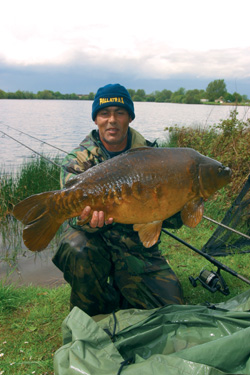 |
| Another Horseshoe twenty falls for a Pallatrax Jungle pop-up |
Twenties
Sure enough, he had the fish in the net 10 minutes later, and it was a manic low twenty, as predicted! Clive’s Raptor hook was well and truly stuck fast in its mouth – it was as good a hook hold as I’d seen in a long time, and was testament to the performance of Clive’s version of the Withy Pool Rig. Could the capture mean the return of the shoal, or would it be a one-off, we wondered?
The answer, unfortunately, was the latter. By noon and well over 24 hours into the session it became obvious that a big hit was not on the cards. That said, Clive and Ian had still caught some cracking fish to well over 20lb – just not the 20 twenties that can be possible at Horseshoe if everything goes to plan. It was time to change tactics.
Ian and Clive wound in and had a walk round the lake. It soon became obvious where the fish were – two other anglers, using exactly the same techniques, had absolutely bagged up during the night from an area of the lake known as the Trout Bank.
Between them they’d caught something like 28 carp to almost 30lb! The fish had left the area where Ian and Clive were fishing and not come back because they’d discovered another huge bed of bait to feed on!
“We chose the wrong swim there,” laughed Clive as he realised his mistake. “It just goes to show that, even with many years of experience on Horseshoe Lake, you can never predict what the fish are going to do!
“Over the seasons I’ve had many, many big hits using the tactics outlined. They do work. It’s just that it was someone else’s turn for a big hit on this occasion.”
![]()


